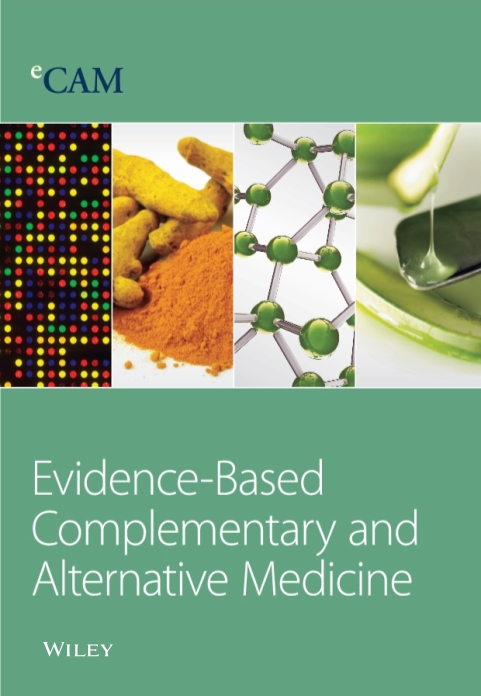Biofilm-Inhibitory Activity of Wild Mushroom Extracts against Pathogenic Bacteria
4区 医学
Q2 Medicine
Evidence-based Complementary and Alternative Medicine
Pub Date : 2024-01-29
DOI:10.1155/2024/7011982
引用次数: 0
Abstract
Objective. This study aims to investigate the bacterial biofilm-inhibitory effect of mushroom extracts. Methods. Mushrooms were collected from Arabuko-Sokoke and Kakamega forests and identified using morphological and molecular approaches. Auricularia auricula-judae, Microporus xanthopus, Termitomyces umkowaani, Trametes elegans, and Trametes versicolor were extracted by chloroform, 70% ethanol, and hot water. Extracts were tested against Escherichia coli, Pseudomonas aeruginosa, and Staphylococcus aureus (ATCC25923). Data were analyzed using SPSS ver. 20.0. Results. Chloroform, 70% ethanol, and hot water extracts of A. auricula-judae (50 μg/mL) showed statistically significant antibiofilm activities against P. aeruginosa, E. coli, and S. aureus (). M. xanthopus extracts (250 μg/mL) revealed significantly significant antibiofilm activities against each test bacterium (). All extracts of T. umkowaani (250 μg/mL) exhibited statistically significant antibiofilm activities against S. aureus only (). Chloroform extract of T. elegans (250 μg/mL) showed the best antibiofilm activity (69.75 ± 0.01%) against S. aureus. All T. versicolor extracts (250 μg/mL) indicated the best antibiofilm activities against S. aureus. Conclusions. Being the first study of its kind to be conducted in Kenya, it added a novel concept to the body of knowledge already known about medical biotechnology research. It offers a fresh understanding of the various varieties of mushrooms found in Kenya, their potential biological function in the production of drugs, particularly those that combat drug resistance, and perhaps even a peek at their bioactive elements. Wild mushrooms, a hidden gem, might help to reopen the pipeline of new antibiotics that have been on the decline. However, further research is required to determine the potential mechanism(s) of action of the extracts that are in charge of the apparent antibiofilm activity.野生蘑菇提取物对病原菌的生物膜抑制活性
研究目的本研究旨在探讨蘑菇提取物对细菌生物膜的抑制作用。方法。从 Arabuko-Sokoke 和 Kakamega 森林采集蘑菇,并通过形态学和分子学方法进行鉴定。用氯仿、70%乙醇和热水提取 Auricularia auricula-judae、Microporus xanthopus、Termitomyces umkowaani、Trametes elegans 和 Trametes versicolor。提取物针对大肠杆菌、绿脓杆菌和金黄色葡萄球菌(ATCC25923)进行了测试。数据分析采用 SPSS ver.20.0.结果A. auricula-judae的氯仿、70%乙醇和热水提取物(50 μg/mL)对铜绿假单胞菌、大肠杆菌和金黄色葡萄球菌()具有显著的抗生物膜活性。M. xanthopus 提取物(250 μg/mL)对每种测试细菌都有显著的抗生物膜活性()。T. umkowaani 的所有提取物(250 μg/mL)仅对金黄色葡萄球菌具有统计学意义上的抗生物膜活性()。T. elegans 的氯仿提取物(250 μg/mL)对金黄色葡萄球菌的抗生物膜活性最好(69.75 ± 0.01%)。所有 T. versicolor 提取物(250 μg/mL)对金黄色葡萄球菌的抗生物膜活性最好。结论作为在肯尼亚进行的第一项同类研究,它为医学生物技术研究的知识体系增添了一个新概念。它让人们对肯尼亚发现的各种蘑菇、它们在生产药物(尤其是抗药性药物)方面的潜在生物功能有了全新的认识,或许还能窥探到它们的生物活性成分。野生蘑菇这一隐藏的瑰宝可能有助于重新打开新抗生素的管道,而这些抗生素的产量一直在下降。不过,还需要进一步研究,以确定这些提取物具有明显抗生物膜活性的潜在作用机制。
本文章由计算机程序翻译,如有差异,请以英文原文为准。
求助全文
约1分钟内获得全文
求助全文
来源期刊
自引率
0.00%
发文量
1983
审稿时长
2.2 months
期刊介绍:
Evidence-Based Complementary and Alternative Medicine (eCAM) is an international, peer-reviewed journal that seeks to understand the sources and to encourage rigorous research in this new, yet ancient world of complementary and alternative medicine.
The journal seeks to apply scientific rigor to the study of complementary and alternative medicine (CAM) modalities, particularly traditional Asian healing systems. eCAM emphasizes health outcome, while documenting biological mechanisms of action. The journal is devoted to the advancement of science in the field of basic research, clinical studies, methodology or scientific theory in diverse areas of Biomedical Sciences. The journal does not consider articles on homeopathy.

 求助内容:
求助内容: 应助结果提醒方式:
应助结果提醒方式:


